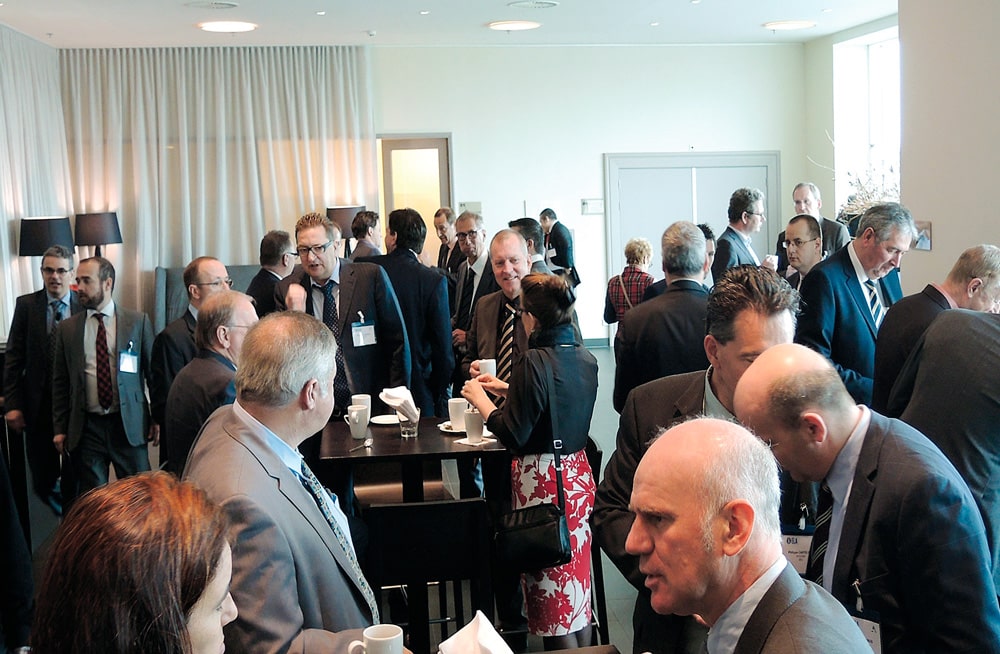“A Safe Ride at the Heart of the Building” reflects importance of keeping abreast of changes.
The Mövenpick Hotel in the world-renowned city of Amsterdam, the Netherlands, played host to the European Lift Association (ELA)’s annual conference on April 10. The venue is in the heart of Amsterdam, on the quayside of the redeveloped port terminal and near the Bimhuis cultural and entertainment complex.
Jean-Pierre Jacobs, ELA general secretary, greeted more than 100 delegates. After everyone had signed in, they took their places in the conference hall. ELA President Philippe Lamalle welcomed guests by explaining the importance of continuing what had been started at the 2013 ELA conference in Istanbul (ELEVATOR WORLD, July 2013), and that the title of the 2014 event, “A Safe Ride at the Heart of the Building,” reflects that goal. Lamalle gave an overview of what would be presented during the sessions and pointed to the many changes to the Lift Directive taking place, as well as the current state of the Safety Norm for Existing Lifts (SNEL) and Safety Norm for Existing Escalators (SNEE) initiatives. Activities included a panel discussion on SNEL and a presentation by Ko Legez, who spoke on the SNEL situation in the Dutch lift industry. Stated Lamalle:
“With this example, as with the other countries’ experiences, we will aim to show that national regulations on the topic are taking quite some time to mature, first because of crisis, but also due to changes in government and lack of political will. However, I am convinced that our continued efforts toward ‘a safe ride in all countries’ will pay off in the end.”
The first session consisted of three presentations, starting with Raimonda Sneigiené of the Directorate-General for Enterprise and Industry, policy officer/manager of the Lift Directive and deputy of the Machinery Directive. Sneigiené explained the implications of the new Lifts Directive 2014/33/EU. She listed a number of lift installer and safety-component manufacturer obligations, including:
- Ensuring the lift has been designed, manufactured, installed and tested in accordance with the Essential Health and Safety Requirements
- Drawing up technical documentation
- Carrying out applicable conformity assessment procedures
- Drawing up a European Union Declaration of Conformity
- Affixing the Conformité Européenne (CE) marking
- Keeping required technical documentation and an EU Declaration of Conformity for 10 years after a lift has been placed on the market
- Keeping a register of complaints and nonconforming lifts
- Ensuring lifts bear a type, batch or serial number or other indentifying element
- Indicating name, registered trade name or registered trademark and manufacturer address on the lift
- Obligations specific to safety-component manufacturers include:
- Taking the corrective measures necessary to bring a safety component into conformity, or withdraw it or recall it, if appropriate
- Informing the competent national authorities of corrective measures taken
- Providing competent national authorities all information and documentation necessary to demonstrate the conformity of safety components
- Cooperate with an authority, at its request, on any action taken to eliminate risks posed by safety components that have been placed on the market
Finally, Sneigiené listed obligations of importers and distributors of safety components, which are to:
- Check whether the manufacturer is complying with its obligations
- Indicate name, registered trade name or registered trademark , and manufacturer address on safety components
- Monitor registered complaints and distribution of information
Sneigiené stressed that instructions should be written in a language that can easily be understood, components must be traceable and there will be market surveillance. In closing, she showed the implementation schedule, which is well underway. Entry into the official Journal occurred on April 19, with full application of the new directive coming on April 19, 2016.
Franck Lesage, co-vice president of Notified Bodies (NBs)-Lifts gave a presentation looking at new legal requirements expected to affect the sector over the next few years. He said the recast of the lift directive approved by the European Parliament on February 5, was crucial, and that this recast will have a new number. Lesage stressed other issues facing the industry, including:
- The obligation of any NB to be accredited according to EA 2/17
- The requirement that units undergo one assessment per year by an approved body
- The fact that there will be very strong rules to follow
Lesage explained that much of the forthcoming work will enhance the credibility of the CE mark and that suitable action to address misleading use of the mark and identification numbers must be taken. In closing, he stressed there are several issues yet to be addressed, including dealing with the transitional period, the total change of numbering of the annex and existing certificates.
A well-known figure in the codes and standards community, Ian Jones was introduced by Lamalle as the father of the recast EN 81-20 and EN 81-50. Jones explained the current state of the code update, as well as the expected timeframe for the transition. Jones stated that the vote on the new EN directive was on April 27, with publication expected in July and a following three-year transition. This means manufacturers can use the existing EN 81-1/2 up to July 2017, when it will be withdrawn. Jones pointed out there are a number of manufacturing considerations that need to be addressed during the transition, including that:
- Product development takes time and manpower and should be considered according to the implementation dates.
- New materials will need to be sourced, and additional components must be purchased or manufactured.
- Some new elements will require new product certification, which needs to be from NBs.
- There may be a need for new product documentation, such as user manuals and certificates that describe new features.
- New installation methods and risk assessments may be required.
- New onsite test procedures to show product conformity may be required.
With so many representatives from national lift associations in attendance, Jones took the opportunity to remind them to advise their members about changes that will be required upon publication of EN 81-20 and EN 81-50. Jones closed his presentation by pointing out that manufacturers should be careful when bringing new products and components to market during the transitional phase, unless they are totally clear about the new code requirements.
After a break, the focus switched to SNEL. Legez reminded everyone where they were in Europe and explained that, until recently, Holland — although densely populated — has favored low-rise buildings. However, this is changing and delegates only need to look out over Amsterdam to see numerous mid-rise developments well underway. Legez also explained that, as the Dutch population ages, the need for lifts and accessibility equipment will increase. It was pointed out that collecting safety data and accident statistics has been very difficult.
Philippe Casteleyn, Inaki Aranburu and Jean-Luc Detavernier jointly presented an update on the SNEL initiative as seen from the Belgian, Spanish and French perspectives. The title was “SNEL — Good Practice in Europe.” Listening to all three presentations, it was clear that a tremendous and challenging effort has been undertaken by the industry and its associations. The political situation and effect, both at local and national levels, is something that needs to be taken into consideration when introducing safety recommendations, and, even if action is agreed upon, a change in government could easily slow or even stop progress.
The final three presentations covered diverse issues and experiences. Gero Gschwendtner, chairman of CEN TC 10 WG 2, concentrated on escalator safety and the SNEE initiative. Ignasi Oliver, director of Maintenance for the Barcelona Metro, introduced delegates to safety issues and the importance of lift and escalator service from clients’ and operators’ points of view. Oliver closed his presentation by calling for closer working relationships with clients so effective solutions may be realized. Adrian Joyce closed the conference with his presentation explaining the objectives of the Renovate Europe campaign. He stressed that if Europe and the world are to reach agreed-upon emission-reduction goals, it is imperative for people and industry to change the way they consume energy and materials.
Get more of Elevator World. Sign up for our free e-newsletter.







